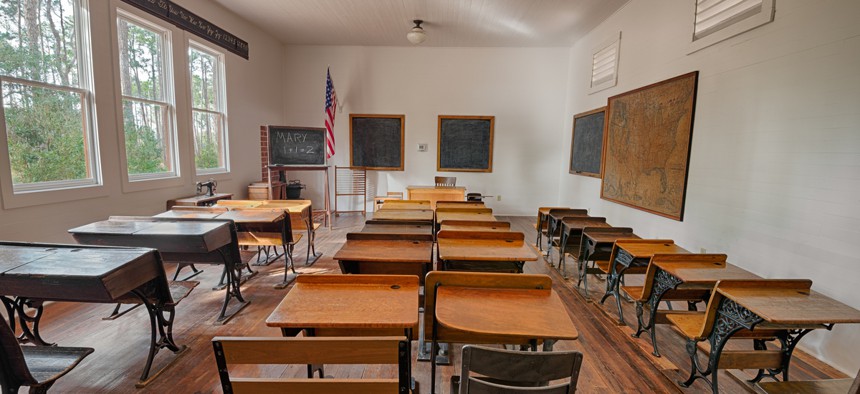Want Better Education in Rural America? Start with Broadband

Urban educational attainment is outpacing that in rural areas. Broadband could help close the gap. Nick Fox/Shutterstock
In all 50 states, urban access to broadband outpaces rural access, and in all but three states, urban areas surpass rural ones in educational attainment.
There are many challenges for those who seek to bridge the urban-rural divide. Rural areas struggle with brain drain and population loss, dwindling job prospects, and slowed economic growth. All these struggles are intricately tied to the lack of twenty-first century infrastructure in many rural areas, namely broadband, which prevents residents from accessing quality education.
Nationwide, rural communities have 37% more residents without access to high-speed internet connections when compared with their urban peers. This becomes a problem as classrooms have become increasingly digital, says Kathryn de Wit, manager of the broadband research initiative at The Pew Charitable Trusts.
“If we want kids in rural areas to have access to the latest curriculum, and to be able to work on their homework once they leave school, we need wide access to broadband,” de Wit said.
De Wit’s explanation of the urban-rural broadband and education divide was the subject of a conversation between local officials and broadband researchers at a Tuesday event hosted by the National League of Cities, the National Association of Counties, and the National Rural Electric Cooperative Association.
Craig Eccher, the president of the Tri-County Rural Electric Cooperative, came to talk about the issues facing his community in northern Pennsylvania. Eccher’s electric cooperative serves just six people per mile, and those customers aren’t just worried about accessing the internet—they’re worried about the cost.
“A lot of kids are on free or reduced lunch in these counties, so broadband access will have to be priced right. Otherwise, how can we reasonably expect them to do their homework?” Eccher said. “70% of our kids are not going on to higher education. Shell is fracking in the area, and that provides good jobs, but they won’t last. What will they do when those jobs dry up?”
Eccher highlighted that putting off broadband now will just make it harder in the future, when people who did not pursue higher education lose their jobs and become nontraditional students. “So we need to be smart about this and do better for this next generation. Without good infrastructure to keep them, they’re going to move away,” Eccher said.
In all 50 states, urban access to broadband outpaces rural access, and in all but three states, urban areas surpass rural ones in educational attainment.
In the 21 states that are underperforming on education standards across the board, 76% have digital divides that “significantly disadvantaged rural areas,” according to Christiana McFarland, research director for the National League of Cities. “There are vastly different opportunities available to people based on where they live. We need more research to fully understand the true impact that the urban-rural divide has on education, but connectivity is at the heart of how we move forward,” said McFarland.
Already, online classes for students in primary school through continuing education programs have been shown to improve opportunities for people in rural areas, according to the U.S. Department of Agriculture. The department’s research also found that internet access in rural areas improves teacher-parent communications. But many places still lack the infrastructure to access these enhanced educational opportunities.
San Leandro, California, used to be one of those communities. Situated between urban and rural parts of the East Bay area, San Leandro has taken a multi-pronged approach to bridging the digital divide that exists in its school system, where 67% of students are on free or reduced lunch. The town brought high-speed internet to its schools, and began to use cloud-based curriculums that allow the children to adapt their learning in real time based on their personal strengths and weaknesses. Corina Lopez, the town’s vice mayor, said that the initiative was necessary to give kids a chance to beat poverty. “We thought providing greater educational opportunities would give them with a fair chance of being competitive in the workforce once they grow up,” Lopez said.
The town also launched a program to bring free wifi to public spaces, and started a partnership with Tech Exchange, an Oakland startup that refurbished computers that the city handed out for free to low-income residents at local libraries.
These types of measures are exactly what de Wit hopes will come to rural America. “We all know the maxim “if you build it they will come,” isn’t that simple. But if you don’t build it, they won’t have the chance,” she said.
All the event speakers agreed that collaboration is necessary to expand broadband. “We need a strong partnership between federal, state, and local governments to address these issues,” said Randy Maluchnick, commissioner of Carver County, Minnesota. Representing an area near the Twin Cities that he described as “half vast suburban wasteland, half prime farming land,” Maluchnick said that the government “can’t expect the private sector to serve six farms.” Instead, Maluchnick said that “local governments can put up the money and do designs—we do that with roads and trails already. We know how to get things done on the ground, so we make a great partner.”
Lopez agreed. “We in communities know where the needs are, but local elected officials are not at the table enough in these discussions,” she said. “We have a wealth of information to share.”
Emma Coleman is the assistant editor for Route Fifty.
NEXT STORY: Roads Suffer When States Focus on Expansion Over Repair, Report Says






